James How and Co.
operated by George John Smith, 1835 – 1905
successor to
James How
operated by James How, 1821 – 1872
successor to
George Knight and Co.
operated by George Knight, Jr., 1812 – 1862
successor to
George Knight and Sons
operated by George Knight, Jr., 1812 – 1862
George Knight, Jr., 1812 – 1862
and Richard Knight, 1813 – 1878
by Brian Stevenson
last updated October, 2024
All known microscope slides labeled “James How and Co.” are of mineralogical specimens (Figure 1). That company was operated not by James How, but by George Smith, a man who probably had worked for How and who purchased the business in approximately 1873. Smith frequently exhibited mineralogical slides to his colleagues at the Royal Microscopical Society and the Quekett Microscopical Club, and extensively advertised such specimens. Judging from Smith’s great interest in mineralogy, but without apparent excitement for other types of specimens, it is not unreasonable to suggest that Smith probably made at least some of these slides himself.
Smith’s predecessor, James How, made and sold a variety of optical instruments and supplies, including microscopes and slides. However, I am not aware of any extant microscope slides marked as having been sold by James How.
James How had acquired his business from his former master, George Knight, Junior. Advertisements published in 1863, when How was beginning his independent business, stated that he had worked for Knight “upwards of twenty years” (Figure 8).
Following is a history of the Knight and How businesses, and biographies of the men who operated them.
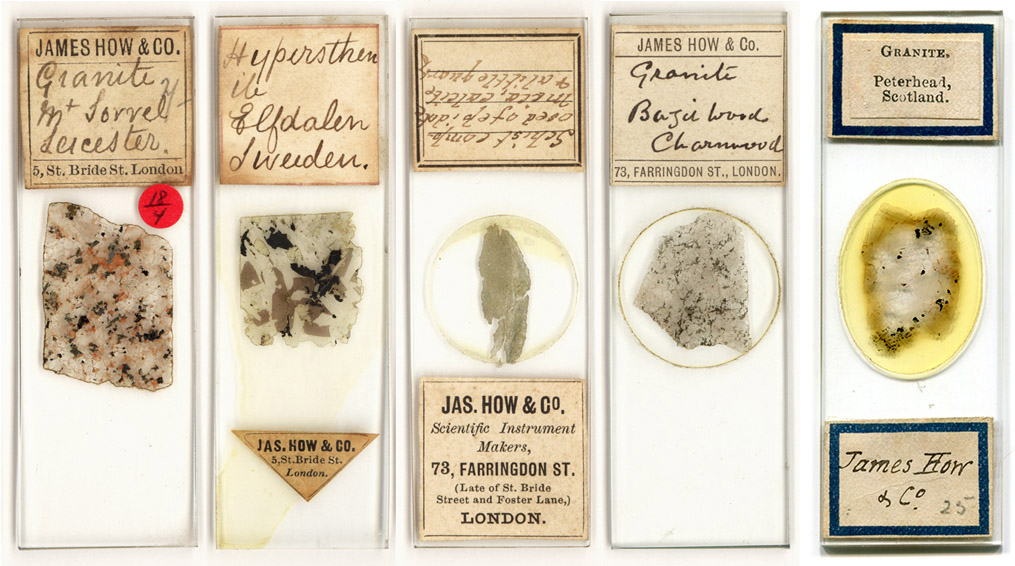
Figure 1.
The company name and addresses indicate that these microscope slides were sold by George J. Smith, who operated James How and Co. from 5 Bride Street between 1876 and 1879, and from 73 Farringdon Street between 1879 and approximately 1891.
George Knight, Jr., was born February 19, 1812 in Islington, London, the second child and eldest son of George and Eliza Knight. George the father was an ironmonger, a trade to which the junior George also applied himself. At some point prior to 1841, young George and his brother, Richard, joined their father’s business, which became known as George Knight and Sons. By that time, the partnership was both an iron dealer and a manufacturer of chemical and photographic apparatus. Father George died in 1845, whereupon the business continued under the same name and operated as a partnership between his sons, George and Richard.
The 1846 Post Office Directory for London recorded George Knight and Sons as “scientific instrument makers” at 2 Foster Lane, and “ironmongers” at 41 Foster Lane. Examples of instruments and supplies produced by Knight (and Sons) are illustrated in Figures 2 and 3. A Culpepper-style microscope attributed to Knight is described, but not illustrated, at http://www.christies.com/lotFinder/lot_details.aspx?intObjectID=946660.
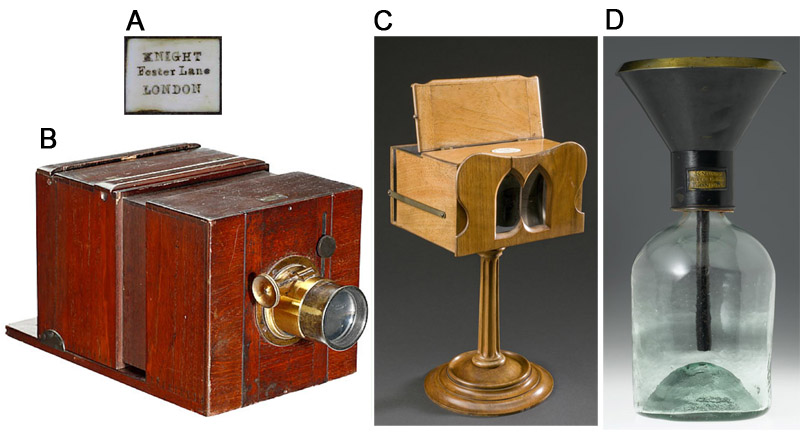
Figure 2.
Optical and scientific instruments produced by
George Knight and Sons.
(A)
Ivory/bone label from Knight, Foster Street, London.
(B) Transitional daguerreotype/plate camera.
(C) Stereoscope, at the Science Museum, London.
(D) Rain gauge, at the Science Museum,
London. Photo credits are listed in below, in the Resources section. Images
used for non-profit, educational purposes according to Creative Commons understandings.
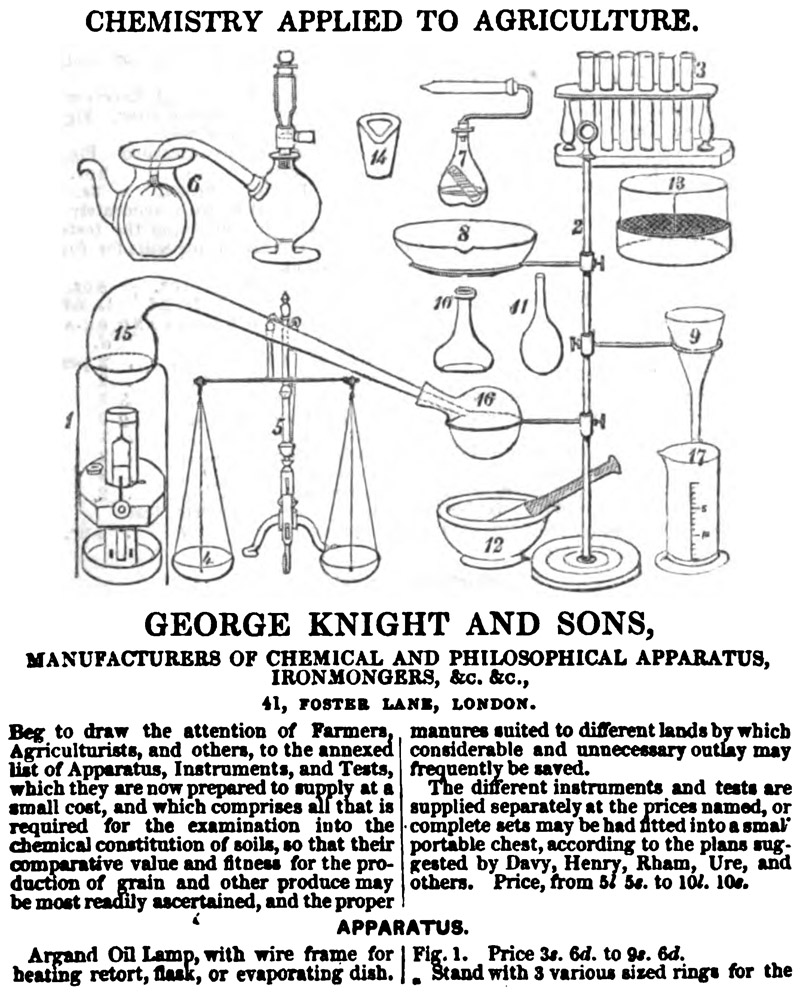
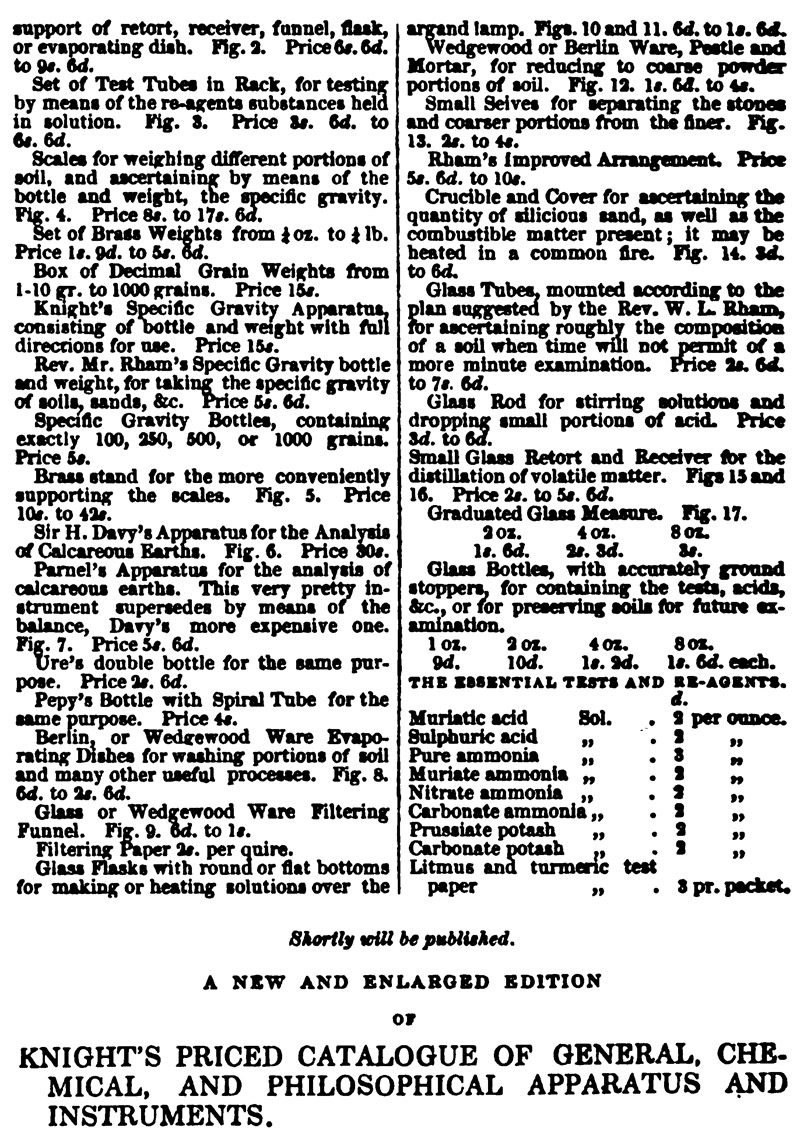
Figure 3.
1844 advertisement for Knight and Sons, from the ‘Farmer’s Almanac and Calendar’.
George Knight and Sons earned a Prize Medal at the 1854 London International Exhibition at the Crystal Palace (Figure 4).
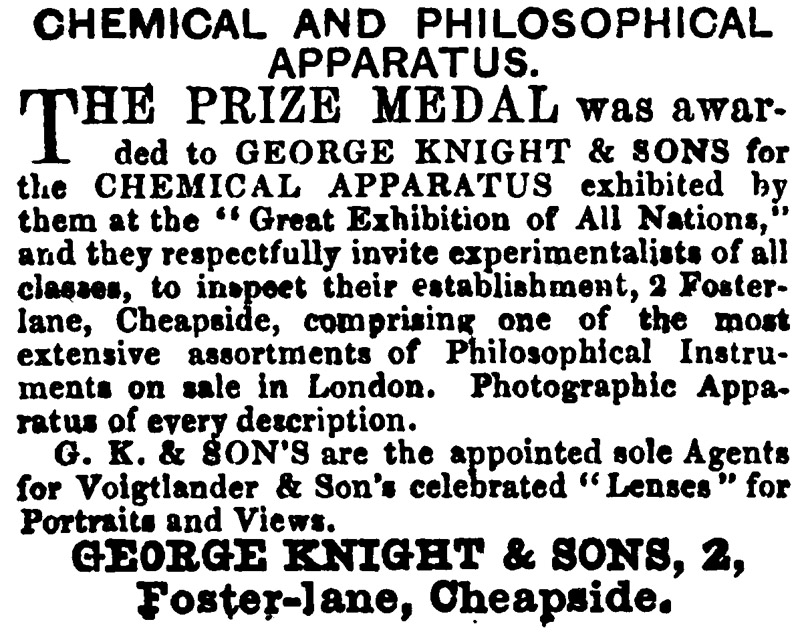
Figure 4.
Advertisement from ‘The Guide to the Crystal Palace and Park’.
In addition to their manufacturing businesses, Knight and Sons published books. Notably, they put out an English language version of Gustave le Gray’s Waxed Paper Process, translated and modified by their assistant, James How (Figure 5). How also wrote an article “On the Production of Waxed Paper Negatives” for the magazine The Chemist in 1854, and the book On the Production of Positive Proofs, from Waxed paper, Collodion and Other Negatives, published by Knight and Sons in 1855. How was described in 1855 by The Chemist as one who “has long paid considerable attention to the art of photography, and is well known as an excellent and reliable authority”.
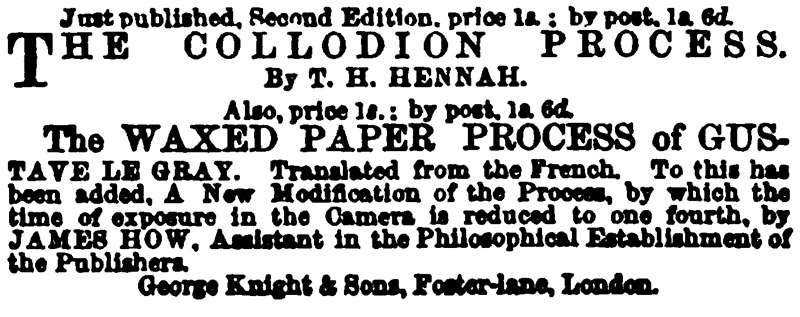
Figure 5.
An 1854 advertisement for books published by George Knight and Sons.
Brothers George and Richard dissolved their partnership in July, 1855. The London Gazette announced, “Notice is hereby given, that the Partnership lately subsisting between us the undersigned, George Knight, and Richard Knight, carrying on the trade or business of Philosophical Instrument Makers, at No. 2, Foster lane, Cheapside, in the city of London, and of Ironmongers, at Nos. 40 and 41, Foster-lane aforesaid, under the style or firm of George Knight and Sons, and carrying on the trade or business of Cochineal Merchants at No. 6, Mincing-lane, Fenchurch-street, and at No. 2, Martin-lane, Cannon-street, in the said city of London, under the style or firm of Richard Knight and Company, has been dissolved by mutual consent – Dated this 7th day of July, 1855. George Knight Richard Knight”.
As a point of clarification, sources such as www.earlyphotography.co.uk confused George’s brother Richard with George’s second son, also named Richard, and have reported that “The partnership between George Knight and his son Richard was dissolved in 1855”. George’s son was born on June 23, 1842, and so was only 13 years old when his father’s company was dissolved. The use of the name George for two generations of the family further confused matters.
George Knight, junior, described himself as an “ironmonger” on his children’s christening records up through 1845, The 1841 census listed both father and sons as being ironmongers, indicating that dealings in iron were the major part of their business during those times. As a probable reflection of his financial success, the younger George listed himself as a “gentleman” on the baptisms of son Edward in 1849 and daughter Ada in 1854. For the 1851 census, the younger George described himself as a “manufacturer of philosophical instruments”, employing 15 men. In 1861, he reported to be a “philosophical instrument maker employing 8 men”. This business was obviously good for the Knights, with both the 1851 and 1861 censuses recording multiple live-in servants. George, his wife Louisa, and their children lived at 46 Regent’s Square, London, from 1842 until his death.
After 1855, the scientific instrument business was operated by George. Advertisements indicate that the business was renamed “George Knight and Co.” (Figure 6), although other people’s references to the shop generally used the old “and Sons” name. George’s business appears to have been centered on the 2 Foster Lane shop. There, he made and sold all manners of equipment and supplies for photography and chemistry. Knight also published scientific books, which included further editions of T.H. Hennah’s Collodion Process in 1856 (Figure 5), and, in 1857, The Chemical Atlas by A. Normandy and A Manual of Electricity by H.M. Noad.
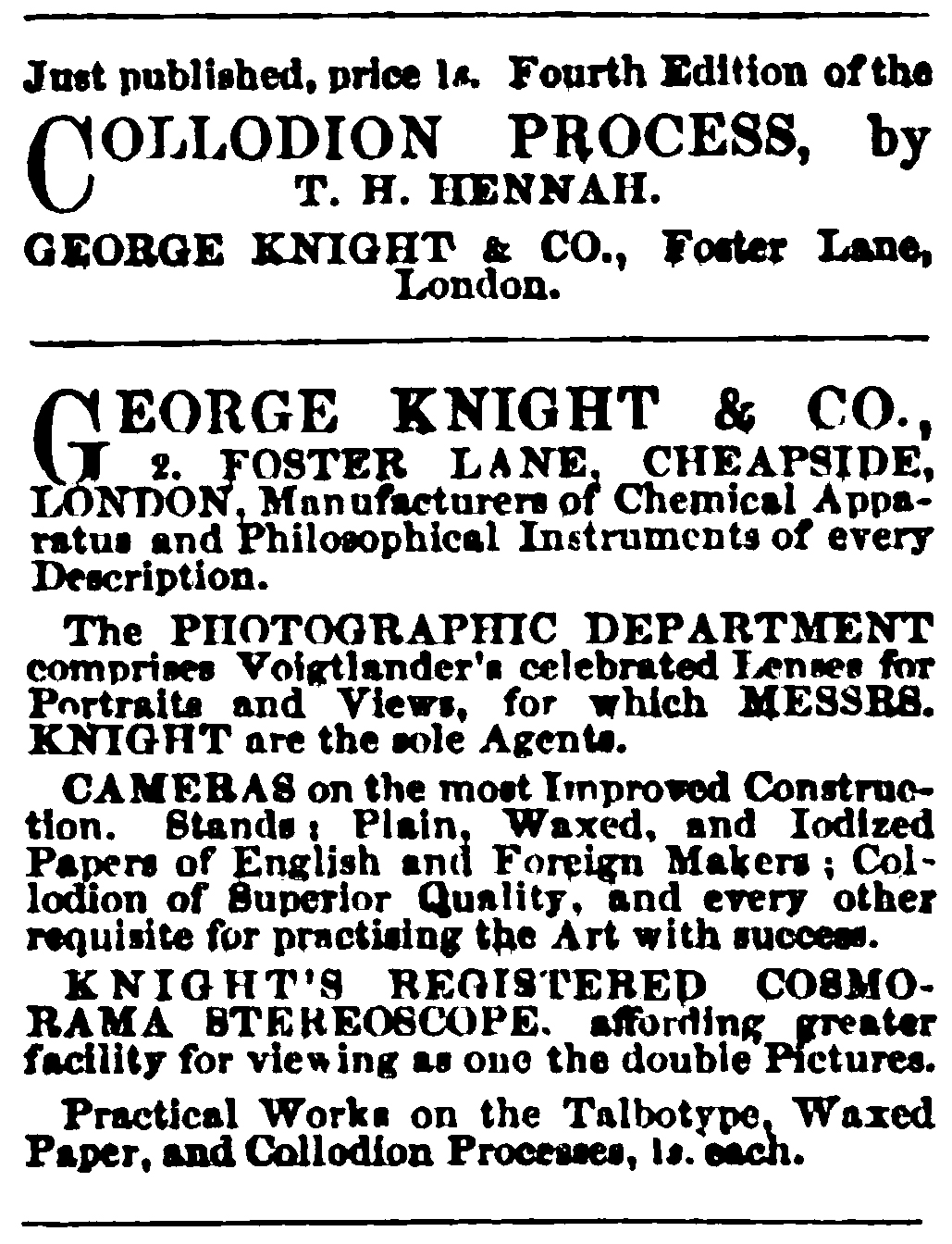
Figure 6A.
1856 advertisements from ‘Notes and Queries’. This was shortly after George Knight dissolved the partnership with his brother, and re-styled the business as George Knight and Company. The business at 2 Foster Lane produced and sold cameras, photographic supplies and a variety of chemicals and apparatus. Knight also published books on photography and chemistry.
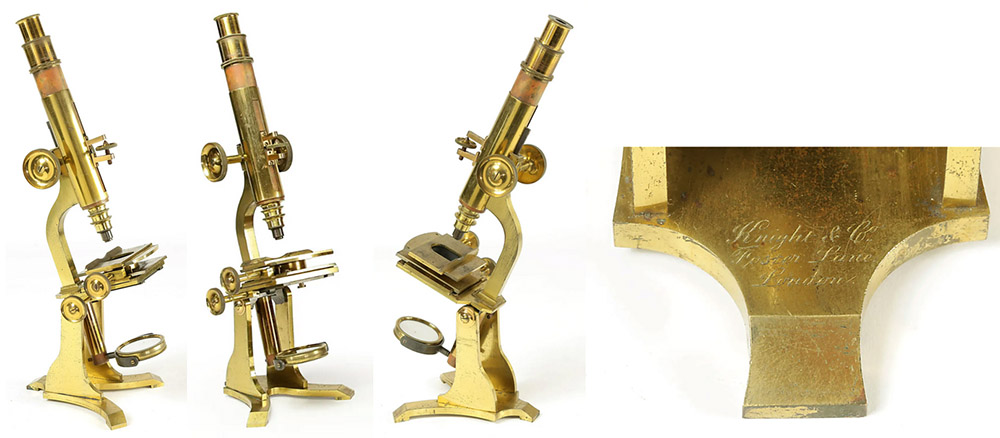
Figure 6B.
ca. 1860 compound microscope, signed "Kight & Co., Foster Lane, London". Adapted for nonprofit, educational purposes from an internet auction site.
George Knight and Co. survived until 1862 (Figure 7). George evidently got heavily into debt, and was forced to sign the business over to his creditors in June, 1862. It is possible that ill health played a role in ending George’s company: he died August 6 of the same year. As further evidence of legal and financial difficulties, George Knight’s will did not clear probate until 1867, and his estate was valued at “under £100”.
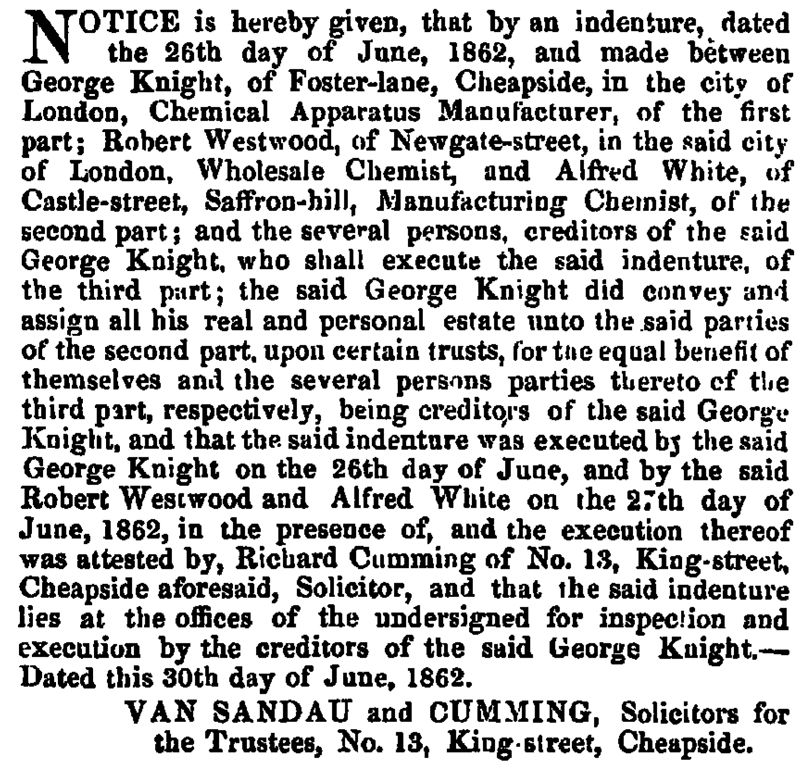
Figure 7.
Notice of George Knight’s bankruptcy, from ‘The London Gazette’.
Shortly after Knight’s foreclosure, the business reopened under the ownership of James How, a former employee. By early 1863, How was advertising a catalog of his products, including “microscopes, microscopic apparatus and objects” (Figure 8). Figures 9 and 10 illustrates microscopes and a microscope lamp made by James How. One of his slide cabinets is shown in Figure 11. As noted above, no slides have been identified that can be conclusively shown to have been sold by How, suggesting he may simply have sold unattributed slides from outside sources. The shop at 2 Foster Lane was described by earlyphotography.co.uk as “a large, wide fronted, premises with a photographers glasshouse at the top ... on the eastern corner of Foster lane and Cheapside”.
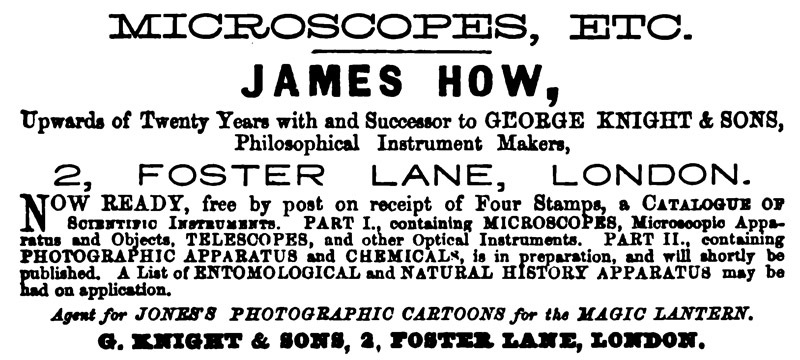
Figure 8.
The earliest identified advertisement for James How’s new business, from the March, 1863 issue of ‘The Intellectual Observer’. Apparently, How had not yet changed the name of the business (or not yet
changed the sign on his shop).
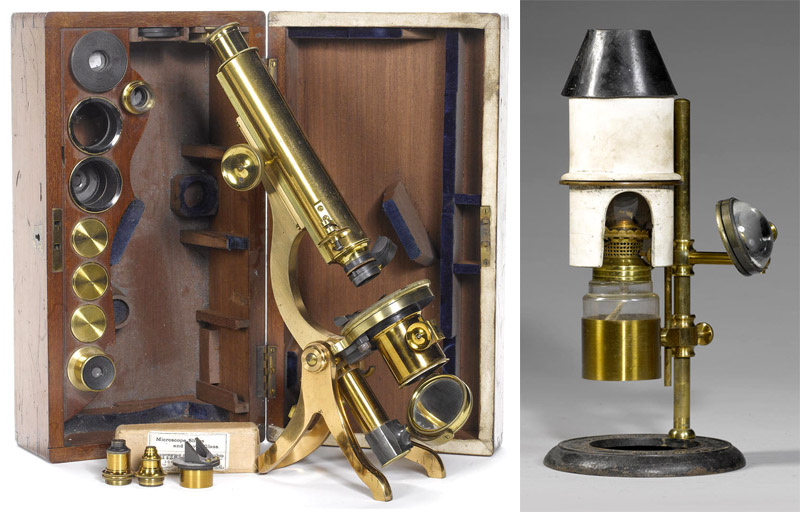
Figure 9.
A microscope and a microscope lamp produced by James How. In that they bear his name, they date between 1862 and 1872. The same model of lamp was sold by How’s successor, James How and Co., until at least the end of the 1880s.
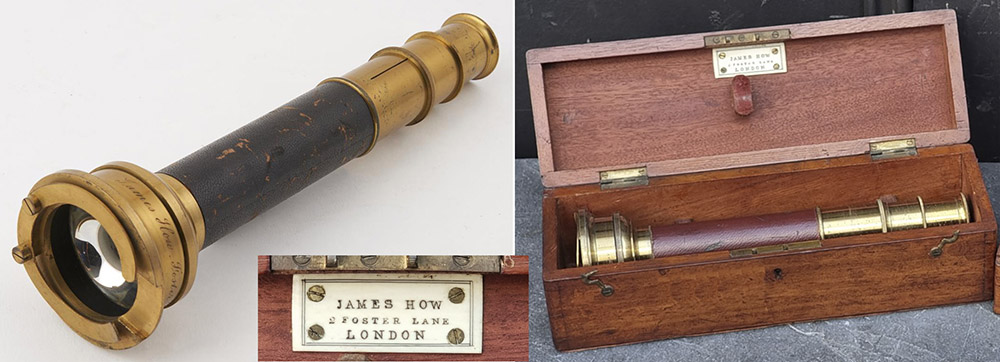
Figure 10.
Demonstration microscopes of the design of Dr. Beale, produced by James How, Foster Lane. Images adapted for nonprofit, educational purposes from internet auction sites.
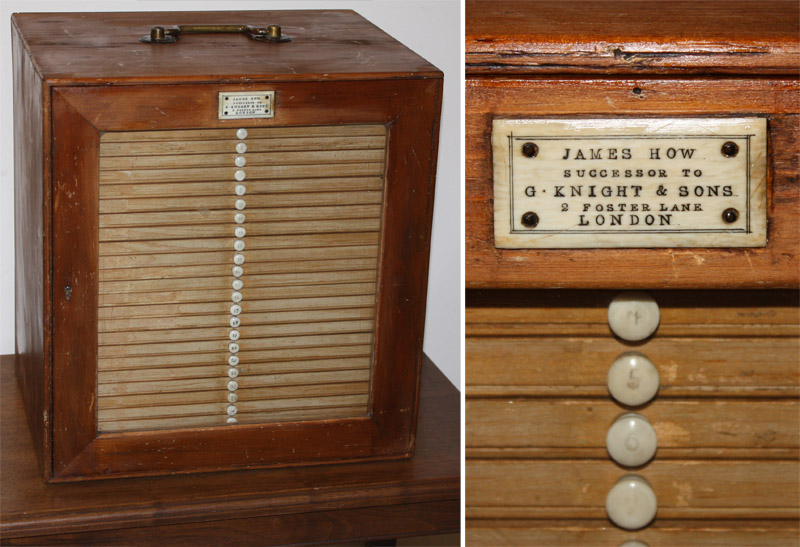
Figure 11.
A large microscope slide cabinet sold by James How, successor to George Knight. Produced between 1862 and 1872. No microscope slides have been identified that can be attributed to the periods when James How or George Knight operated the optical shop at 2 Foster Lane.
James How was born March 8, 1821, in Greenwich. Kent, to William and Susannah Coleman How. James’ father was a carpenter. The 1841 census recorded the twenty year-old James as working as a butcher.
His 1863 advertisements described James How as having worked with George Knight for approximately 20 years (Figure 8), indicating a career change and move to London around 1843. How’s obituary described him as having been Knight’s “manager”. The 1848 christening record of his eldest daughter stated that James then worked as a “chemist”, and the 1861 census described him as a “chemist warehouseman”, suggestive of a primary occupation with the Knight photography business. Judging from How’s production of microscopes and other optical instruments, it is reasonable to assume he also received training in lens grinding and other skills of the optician trades. He described himself as an “optician” for the 1871 census.
James and his wife, Emily, raised six children. The family was relatively well-off by 1871. They did not live at the shop, but instead lived at 42 Gresham Road, Brixton, Surrey. James evidently commuted to work. They employed a domestic servant, another sign of modest luxury.
Although microscope slides sold by How have not been identified, photographs in magic lantern slides are known (Figure 12). James How produced a large series of photomicrographs (small objects enlarged by photography through a microscope) taken by Richard Maddox. The 1867 Catalogue of the Educational Division of the South Kensington Museum described a “Series of Enlarged Photographs of Microscopic Objects; the Negatives by Dr. Maddox, printed by J. How. These are also mounted as Slides for the Magic Lantern, price 6d. each (in frame, glazed). Also 6 Specimens mounted on Card”.
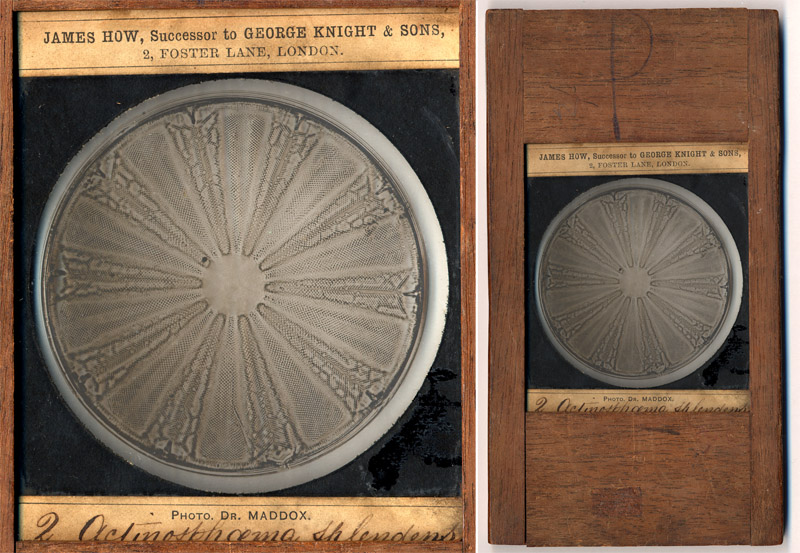

Figure 12A.
Two lantern slides of diatoms, produced by Richard Maddox and sold by James How. The slides measure 3 x 3 inches (75mm x 75 mm), with original mahogany wood frames that are 3 ¾ x 7 inches (95 x 175 mm). Close-ups of the photos appear to the left, and full views of the wooden-framed slides are shown to the right. Both of these subjects were exhibited in 1864 by
James How to the Photographic Society of London.
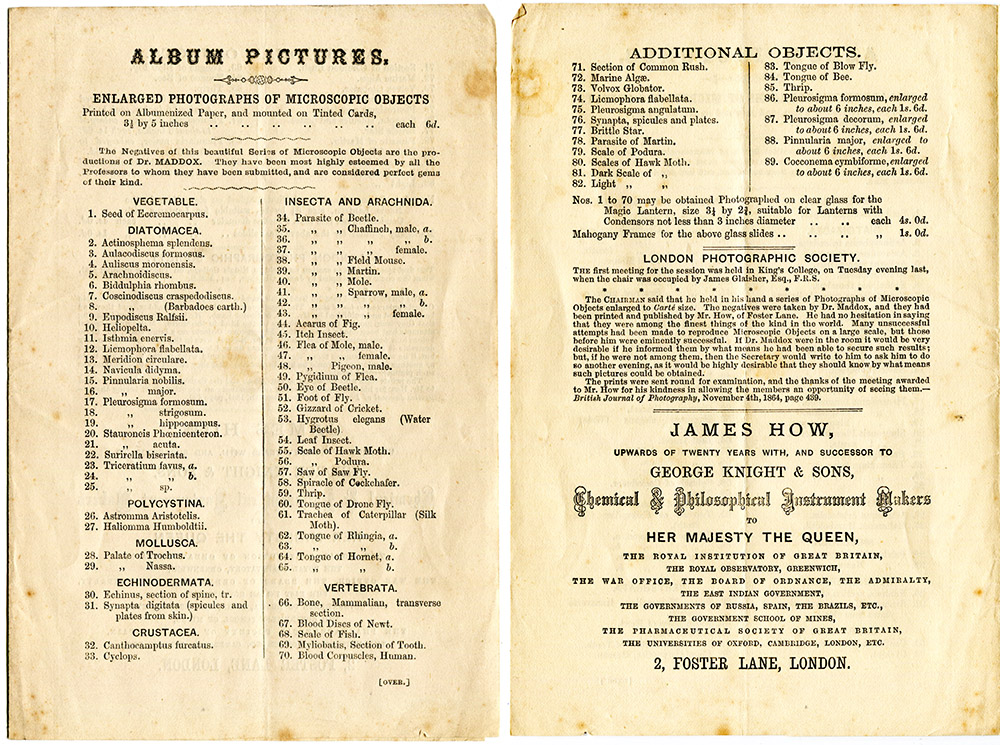
Figure 12B.
A ca. 1863 list of R.L. Maddox's photographs that were avaialble for sale at James How's shop.
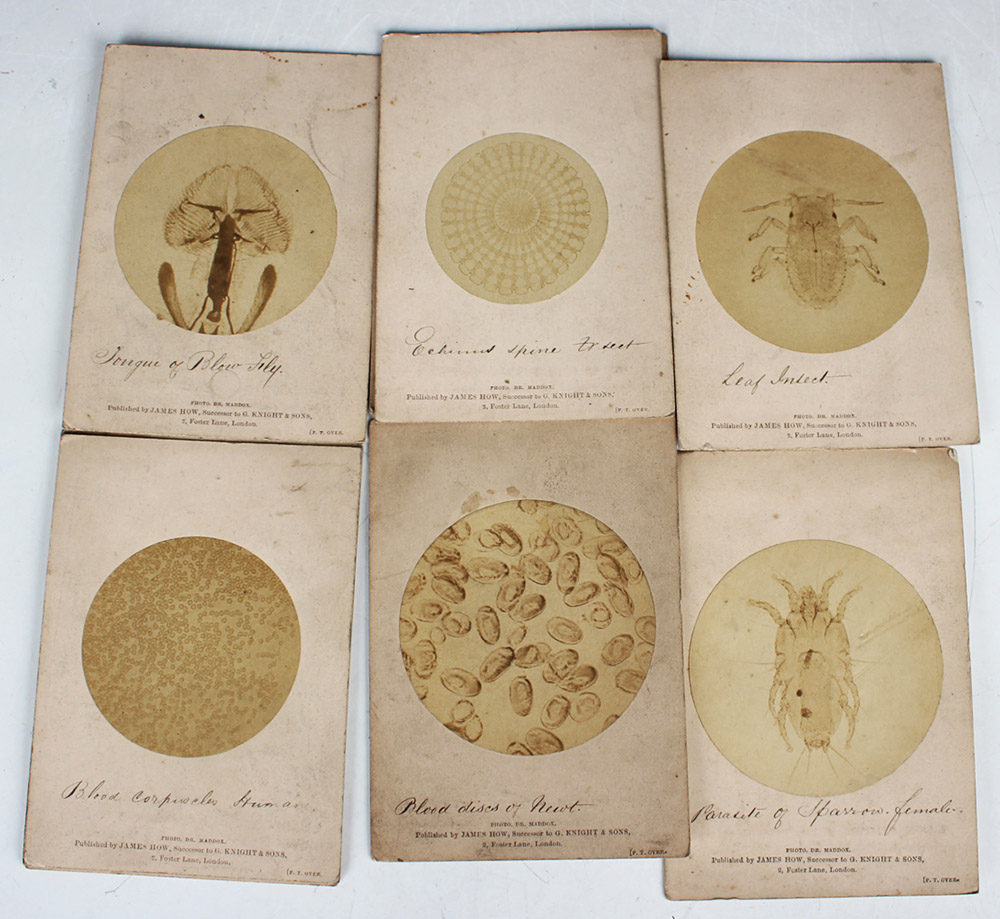
Figure 12C.
Cards bearing photomicrographs by Richard Maddox, that were sold by James How. Adapted for nonprofit, educational purposes from an internet auction site.
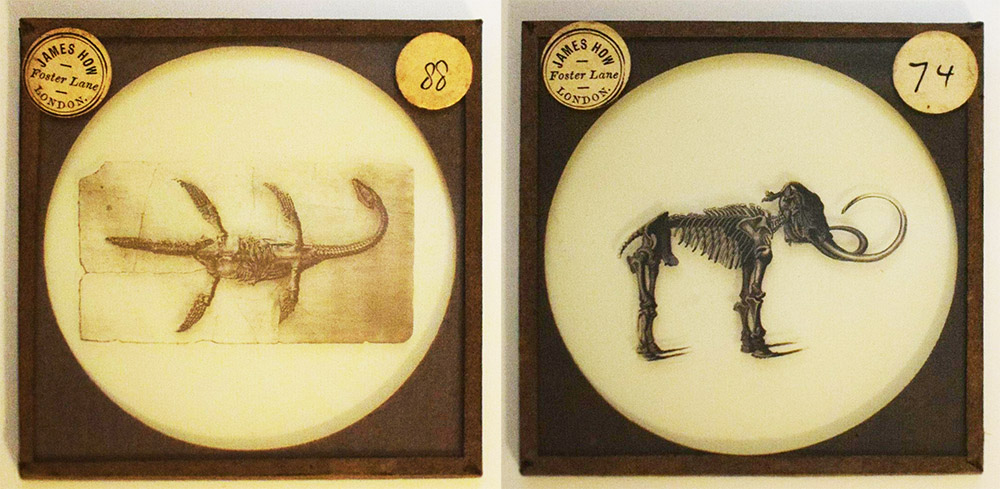
Figure 12D.
Two ca. 1863-1872 lantern slides, retailed by James How. Adapted for nonprofit, educational purposes from an internet auction site.
At the November 15 and December 15, 1864 meetings of the Photographic Society of London, James How “exhibited, on a disk of about 7 feet diameter, by means of the oxyhydrogen lantern, a series of beautiful microscopic photographs taken by Dr. Maddox, some of them with the highest-power object-glasses. These marvelous productions excited universal admiration . . . The following are among those which were most admired: Vegetable. - Seed of Eccremocarpus. Diatomaceae. - Actinosphenia splendens; Aulaeodiscus formosus; Auliscus moronensis; Coscinodiscus (Barbadoes earth); Liemophora flabellata; Navicula didyma. Echinodermata. - Echinus, section of spine, tr.; Synapta digitata (spicules and plates from skin). Crustacea. - Canthocamptus furcatus; Cyclops. Insecta and Arachnida. - Parasite of Beetle Parasite of Field-Mouse; Parasite of Mole Parasite of Sparrow, female; Acarus of Fig; Itch-insect; Flea of Mole, male; Flea of Mole, female; Flea of Pigeon, male; Eye of Beetle; Foot of Fly; Gizzard of Cricket; Hygrotus elegans (Water-Beetle); Leaf-insect; Scale of Hawk Moth; Spiracle of Cockchafer; Tongue of Drone Fly; Tongue of Rhingia; Tongue of Hornet. Vertebrata. - Blood-corpuscles, Human. The Chairman said that he regarded it as a great achievement in photography to render, with such perfection as they had seen on the screen, objects so small in size that four millions of them would be required to cover one square inch. Those Members who wished to see more of them might do so at Mr. How's place, in Foster Lane. There were a hundred of them, and only twenty had been shown”.
“The Chairman called attention to a series of photographs of microscopic objects by Dr. Maddox, which were exhibited by Mr. How. They were, he thought, the best photographs of the kind he had ever seen. Photographs of microscopic objects had hitherto generally been failures; but these struck him as being really the finest in the world ... He would recommend any Member who happened to have a lens with him to examine the prints carefully, as they would well repay such an examination”
How displayed his products at the 1867 Paris Universal Exhibition. According to the catalogue, these included “photographs”, a “photography tent” (portable dark room) and a “field box” (probably a portable, light-tight box that one could reach inside to manipulate photographic plates, protected from daylight).
As did his former master, James How also published scientific books. These included Urinary Analysis, by Robert Venables, in 1868.
James was elected a Fellow of the Royal Microscopical Society on February 10, 1864. He also joined the Quekett Microscopical Club on March 27, 1868, shortly after it was formed. At the 1866 Annual Soiree of the Royal Microscopical Society, “Mr. James How had some beautiful examples of Zoophytes with expanded tentacles, Halodactylus, Sertularia, &c.; the larvae of the shore crab, circulation of the blood in the frog, specimens of Trichina spiralis in human muscle, &c. Mr. How also exhibited, in one of the rooms upstairs, by means of the oxyhydrogen light, a selection of photo-micrographs by Dr. Maddox, consisting of vegetable structures, diatoms, parasites, parts of insects (some of these exhibited for the first time), such as preparations of the head and wings of the male and female gnat, and larvae and pupa state of the same, and a fine photograph of the tongue of the house-cricket”. Clearly a good salesman, How did not waste opportunities to display his products to potential customers. He was also recorded as displaying microscopes and lamps at RMS and QMC meetings.
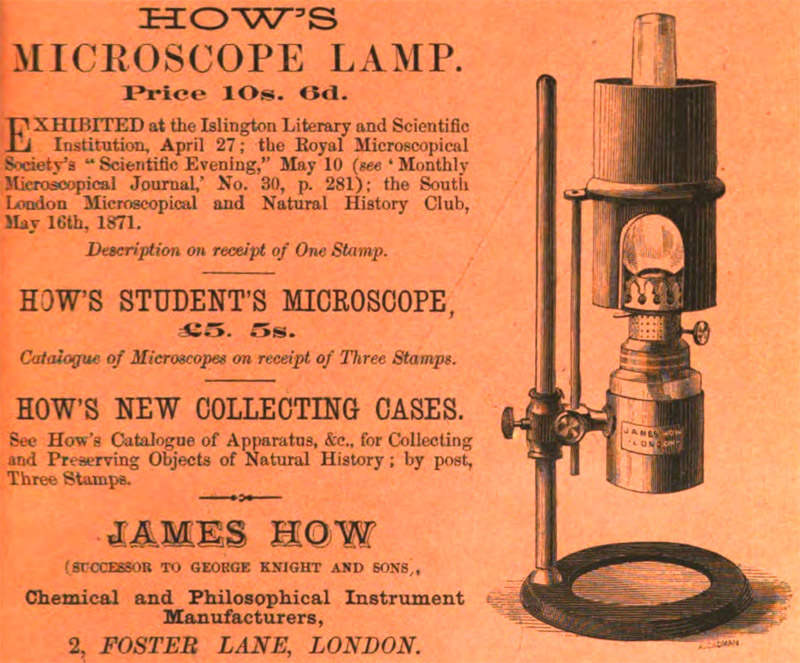
Figure 13.
1871 advertisement from the cover of ‘The Monthly Microscopical Journal’.
In early 1873, the Monthly Microscopical Journal reported, “Mr. James How, the well-known philosophical instrument maker of Foster Lane, recently complained of a small tumour that had appeared behind one of his ears, which, on the following day, became so painful as to compel him to leave his business. The tumour rapidly developed into a carbuncle, and erysipelas supervening, he died on Sunday, the 8th of December, 1872, at the comparatively early age of fifty-two. Mr. How was for many years manager of the business of the late firm of George Knight and Son, Foster Lane, whom he afterwards succeeded. He was intimately conversant with the practical details of photography in its numerous ramifications, and several years since published his method of producing negatives by the waxed-paper process, a process which he simplified to a very great extent, and by which he produced many fine photographs. He was elected a Fellow of the Royal Microscopical Society on the 10th of February, 1864. Mr. How introduced a cheap students' microscope, which was admitted to be one of the best instruments of its class, and his skill in exhibiting microscopic photographs and similar objects was widely known and appreciated”. His will left “under £3,000” to his widow, Emily.
The business continued under other ownership for at least two more decades, using the name “James How and Company”. The similarity in names has led many historians to assume that How was still alive and operating the company for all that time.
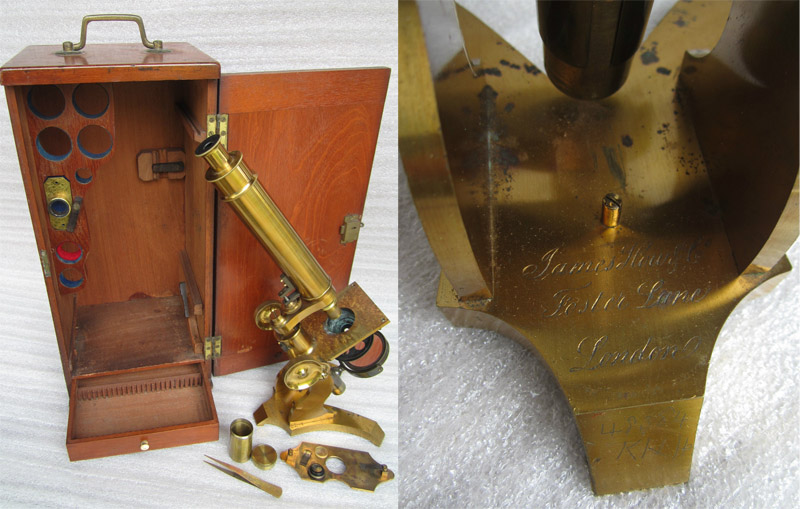
Figure 14.
A microscope signed “James How and Company”, with the address of Foster Lane, dating it to ca. 1875.
To the best of my knowledge, George John Smith bought James How’s shortly after How’s death. Smith joined the Quekett Microscopical Club on June 27, 1873, an indication of his ascendency into the world of well-connected microscopists. He was elected Fellow of the Royal Microscopical Society in 1881. Smith was described in the 1881 census as being an “optician master”, implying that he was skilled in lens grinding and other optical-related skills. His election to the RMS and QMC also suggest microscopical artistry. Those skills would have required an apprenticeship. Smith may have apprenticed with How, or, alternatively with Smith’s father-in-law, Joseph Bloomfield. The parish record of Smith’s 1861 marriage to Caroline Bloomfield noted that her father was an “optician”. The 1861 census described George Smith as a “practical chemist”, a further suggestion that he worked for James How and George Knight before taking over the business.
George John Smith was born ca. April, 1835, to Thomas and Jane Smith. He was christened May 3, 1835 at Spitalfields Christ Church with St. Mary and St. Stephen, (now within London). George’s father, Thomas, was a butcher.
Presumably, Smith retained the How name for his company in order to take advantage of How’s good reputation. Smith appears to have sold the same models of microscopes and lamps as did How. The name of the new business seems to have confused even members of the Quekett Microscopical Club, to whom both How and Smith should have been known: the Journal of the Quekett Microscopical Club report of the 1875 Annual Soiree stated, “Mr. G.J. Smith, for Mr. How - Large Binocular Microscope; Students' and popular Binocular Microscopes; transparent Anatomical preparations, &c.”
The above-mentioned report implies that How and Co. sold slides of anatomical sections. No microscope slides are known that are labeled with the Foster Street address, suggesting that they may have been produced by an outside source(s) without labels that identify How & Co.
During the autumn of 1876, Smith moved the James How and Co. shop from Foster Street to 5 St. Bride Street (Figures 15 - 17).
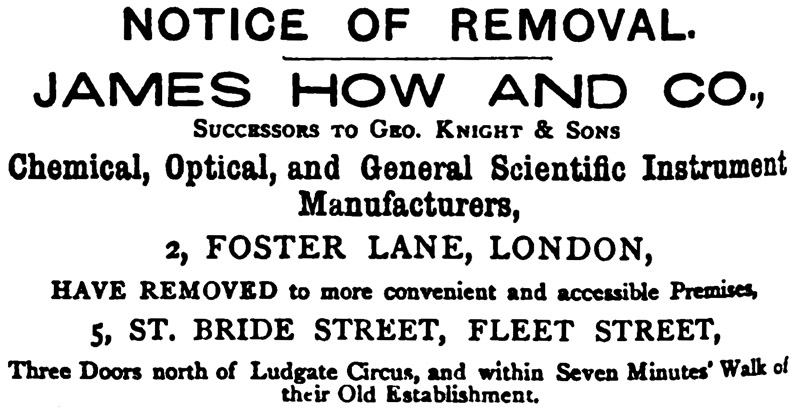
Figure 15.
Smith moved his business to 5 St. Bride Street during the autumn of 1876. Advertisement from the November 2, 1876 issue of ‘Nature’.

Figure 16.
A How and Co. microscope slide, sold from their location at 5 St. Bride Street.
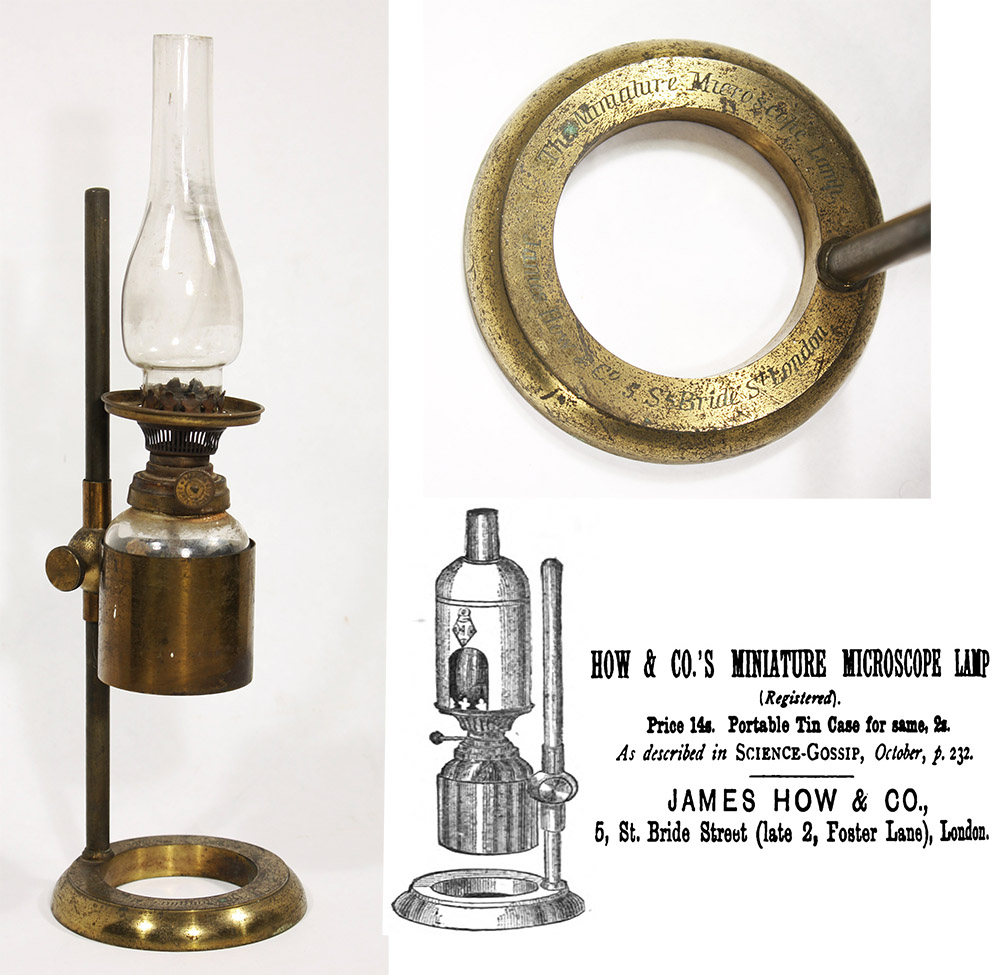
Figure 17.
A How and Co. "Miniature Microscope Lamp" microscope slide, produced at their location at 5 St. Bride Street. It originally posessed a ceramic shade, now lost. The inset is an advertisement from the January, 1879 issue of "Hardwickes Science-Gossip". The previous November, that magazine described its introduction: "We have recently tried the above-mentioned lamp, just introduced by Messrs. How & Co., St. Bride-street, Ludgate Circus, London, and find that, although very much smaller than those hitherto in use, it affords a pure white light sufficient for all microscopic purposes. One of the advantages of its small size is the much less heat given off, a somewhat important matter, when a dozen or more lamps are burning simultaneously. It is fitted with the Improved Hailes shade; this in its original form, as most of our readers are aware, was that of a porcelain cylinder, with an aperture at the lower part, the rest of the light being obscured; it was supported by a brass ring sliding on the upright rod of the lamp. One fault in this form of shade was that a great amount of light was visible above it, and generally on a level with the eye of the observer. In the new shade this has been obviated by the upper part being made dome-shaped, the eyes being thus effectually protected from glare. The shade is supported by a gallery just below the burner; it is therefore always in position. not in use, is packed in a japanned tin case, about 3 inches in diameter, and 9 inches in height, and weighs under two pounds".
Like his predecessors, Smith displayed his microscopes, magic lantern slides and other products at meetings. These were often among the displays of commercial suppliers, enhancing their function as advertisements to his fellow society members and visitors. For example, the report of the 1877 Annual Conversazione of the Quekett Microscopical Club read, “By permission of the Council of University College, a Conversazione was held in the Museum, and the East and South Libraries, on Friday, the 13th of April. About 1,050 ladies and gentlemen were present. 120 microscopes were brought by the members of the Club, and 60 by members of the South London, the Croydon, the Sydenham, the Greenwich, and the New Cross Societies. The leading London Opticians also kindly lent their assistance, as on former occasions . . . Among the large number of excellent professional exhibits, the following were particularly noticed: Messrs. Jas. How and Co. (by Mr. G.J. Smith). - Popular Binocular and Students' Microscopes. Sections of Rocks - Igneous, Sedimentary and Metamorphic, &c.” and “Mr. G. J. Smith (James How & Co.) exhibited at intervals, during the evening, by means of the oxy-hydrogen apparatus, in one of the dark rooms, Views of Scottish Scenery, Statuary, Photomicrography, Experiments with Polarized Light, &c.”
A report of the 1881 conference of the British Association (a preeminent general science organization) stated “Further on were to be seen a collection of mineral and rock sections, exhibited by Messrs. James How & Co., of London; this firm also exhibiting a beautiful collection of lantern transparencies, chiefly geological and physiological, for the illustration of scientific lectures by means of the lantern.”
George Smith appears to have been particularly interested in studies of rocks and minerals. All known instances of Smith exhibiting microscope slides to his RMS and QMC colleagues involved sectioned mineral specimens. As examples, during 1878, he displayed to the QMC “Graphic Granite from Scotland” and “Ptychodus tooth from chalk” on March 8, and “Sherzolite from the Pyrenees, &c.” on May 18. To the RMS, he exhibited “Sections of dolerite with unaltered olivene and syenite, from Peru” on April 20, 1881, “Limestone with shells, from Headon Beds, Christchurch Bay, Hants. Quartz Diabase from Freiburg, with polarized light” and “Augite, Syenite, Propylite, &c, with polarized light” on November 26, 1884, and, on November 28, 1888, “(1) Olivine Dolerite, Glacial Drift, Finchley. (2) Basalt (columnar) with Olivine, Erpel, Linz, Rhine. (3) Micropegmatite. (4) Pikrite, Tringenstein. (5) The Fayette Meteorite, Bluff Settlement, Colorado River, Bluff Co., Texas. (6) Ejected blocks of Trachytic Lava from the Tuff of the Lacher See, Eifel, Prussia. Print advertisements also emphasized mineral sections (e.g. Figure 18). His great interest suggests that Smith would have produced at least some thin-sectioned mineral slides. However, it is not known whether he produced the slides sold by How and Co., or if they were brought in from outside sources. Those slides sold for between 1 ½ and 2 shilling each in the mid-1880s, and so could have been a fairly profitable commodity.
The How and Co. business moved a second, time, in mid-1879, to 73 Farringdon Street (Figure 18). It remained at that location until Smith ceased business, which was in the early 1890s.

Figure 18.
Smith moved the business again, during the summer of 1879, to 73 Farringdon Street. Advertisement from the August 21, 1879 issue of Nature.
The 1881 census recorded George J. Smith as being an “optician master employing 3 men, 1 boy”. His son, 18 year-old George Bloomfield Smith, was an “optical turner”, presumably working for his father as a lens grinder. Both father and son were listed as “scientific instrument maker” on the 1891 census.
James How and Co. came out with a compact, portable microscope lamp in the mid-1880s. An advertisement from Hardwicke’s Science-Gossip described the “Pocket Microscope Lamp” as “very convenient and portable, gives ample Illumination, has all necessary adjustments, is provided with a Cylindrical Case, and can be conveniently carried in the breast coat pocket; when charged with sufficient Oil to burn for above 3 1/2 hours, weighs under 12 oz. Price 8s. 6d. Microscopists who are in the habit of exhibiting at the Meetings of their respective Societies and elsewhere, should provide themselves with this little Lamp. Micro-Petrology, Typical Rock Sections, 1/6 AND 2/- each. James How & Co., 73, Farringdon Street, London.”
The last, identified sign of the James How and Co. business was an advertisement published Hardwicke’s Science-Gossip during 1892 (Figure 19). I did not find any references to the business after that point, although Smith was still actively exhibiting mineralogical microscope slides to his colleagues in 1894. Thus the Knight-How-Smith chain of optical businesses likely ended in the early- to mid-1890s.
George Smith’s wife, Caroline, preceded him in death, passing away in early 1887. Smith son, George, and youngest daughter, Mabel, were living with their father in 1891. By the time of the 1901 census, George J. Smith was a pensioner at Sutton’s Hospital, Charterhouse, London. He died there, on May 5, 1905.

Figure 19.
The last identified advertisement from How and Company, Hardwicke’s Science-Gossip, 1892.
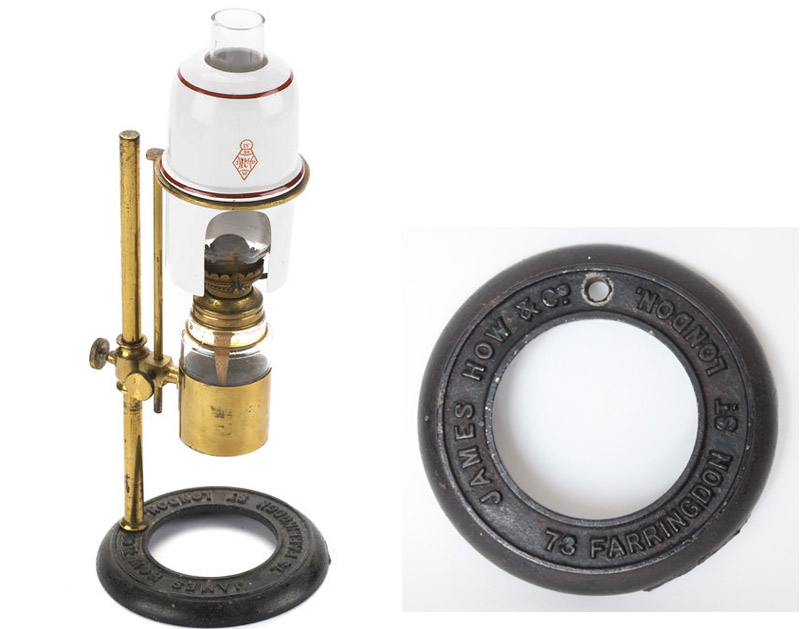
Figure 20.
A microscope lamp from James How & Co. That name, and the Farringdon St. address date this lamp to between 1879 and the early 1890s.
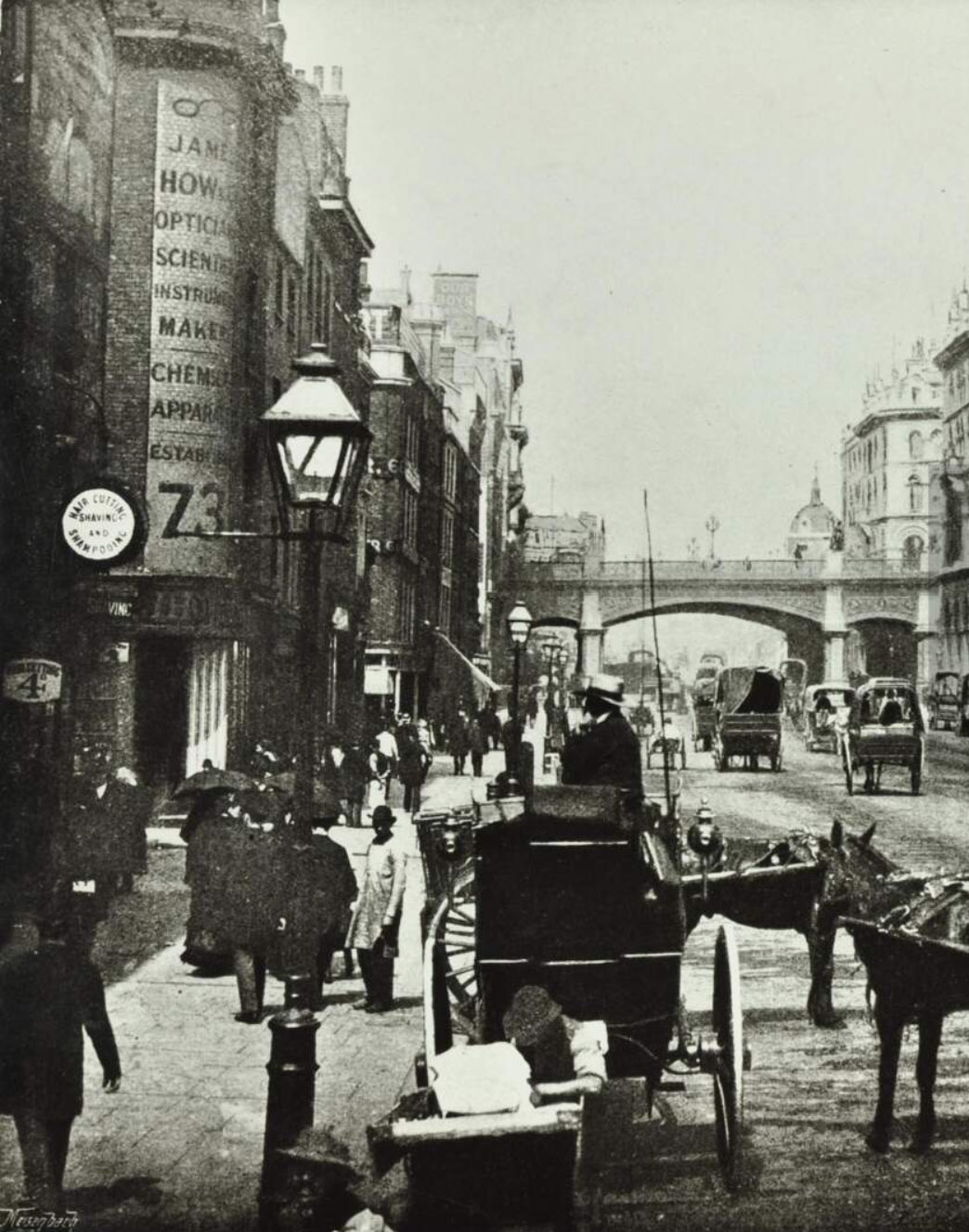
Figure 21.
Farringdon Street, 1890, with James How & Co. on the left. Adapted for nonprofit, educational purposes from an image on pinterest.
Resources
The Atheneum (1854) Advertisement for Waxed Paper Process, translated by James How and published by George Knight and Sons, Sept. 2, page 1073.
Bracegirdle, Brian (1998) Microscopical Mounts and Mounters, Quekett Microscopical Club, London, pages 53, 144, and 206, and plates 20 and 51.
Catalogue of the Educational Division of the South Kensington Museum (1867) Eight edition, page 382.
The Chemist (1855) Review of James How’s book On the Production of Positive Proofs, from Waxed paper, Collodion and Other Negatives, New Series, Vol. 2, page 704.
Christening record of Ada Constance Knight, born March 28, 1854 (1854) St. Pancras Parish records, accessed through ancestry.co.uk.
Christening record of Edward Martin Knight, born April 8, 1848 (1849) St. Pancras Parish records, accessed through ancestry.co.uk.
Christening record of Emily How, born August 16, 1848 (1848) St. Giles without Cripplegate Parish records, accessed through ancestry.co.uk.
Christening record of George Knight, born February 19, 1812 (1815) Islington St. Mary Parish records, accessed through ancestry.co.uk. Also includes birth information on siblings Eliza and Richard.
Christening record of George Henry Knight, born June 23, 1842 (1843) St. Botolph Aldersgate Parish records, accessed through ancestry.co.uk.
Christening record of George John Smith, baptized May 3, 1835 (1835) Spitalfields Christ Church with St Mary and St Stephen Parish records, accessed through ancestry.co.uk.
Christening record of Richard Knight, born July 19, 1843 (1843) St. Pancras Parish records, accessed through ancestry.co.uk.
Christening record of Louisa Rosalind Knight, baptized November 24, 1845 (1845) St. Pancras Parish records, accessed through ancestry.co.uk.
Early Photography (accessed October, 2012) Knight, http://www.earlyphotography.co.uk/site/companies1.html
England census, birth, marriage, death and other records, accessed through ancestry.co.uk
Family tree record of George Knight, senior (accessed October, 2012), http://trees.ancestry.co.uk/tree/45210109/person/6379218339.
Farmer’s Almanac and Calendar (1844) Advertisement for George Knight and Sons, pages 171-172.
Grosses Adressbuch der Kaufleute, Fabrikanten und handelnden Gewerbsleuten von Europa und den Hauptpläzen der fremden Welttheile (1841) Chemical apparatus makers: Knight, George et Sohn. 2 Foster lane, Vol. 21, page 20.
Guide to the Crystal Palace and Park (1854) Advertisement for George Knight and Sons, Vol. 1, page 37.
Hardwicke’s Science-Gossip (1872) Advertisements for James How, Vol. 8, July and August issues.
Hardwicke’s Science-Gossip (1878) The Miniature Microscope Lamp, Vol. 14, page 232.
Hardwicke’s Science-Gossip (1879) Advertisement for James How, Vol. 15, page xxii.
Hardwicke’s Science-Gossip (1889) Advertisement for James How, Vol. 25, pages ii, lvii and xc.
How, James (1854) On the production of waxed paper negatives, The Mechanics’ Magazine, Vol. 60, pages 531-535. Reprint of a presentation that How originally read to the Chemical Discussion Society on May 11, 1854 and published in The Chemist, 1854.
The Intellectual Observer (1863) Advertisement for James How, Vol. 3, March issue advertiser.
Journal of Microscopy (1894) Exhibit by G.J. Smith, (snippet from Google Books).
Journal of the Photographical Society of London (1864) Descriptions of James How’s exhibitions of Maddox photographs, Vol. 9, pages 133-155.
Journal of the Quekett Microscopical Club (1868) List of Members, Vol. 1.
Journal of the Quekett Microscopical Club (1875) Annual Soiree, Vol. 4, pages 71-76.
Journal of the Quekett Microscopical Club (1877) Conversazione, Vol. 4, pages 294-300.
Journal of the Quekett Microscopical Club (1878) Club meeting records, Vol. 5, pages 69 and 97.
Journal of the Quekett Microscopical Club (1884) Members, Series 2, Vol. 2.
Journal of the Royal Microscopical Society (1881) Conversazione, Series 2, Vol. 1, page 552.
Journal of the Royal Microscopical Society 1884) Conversaziones, Series 2, Vol. 5, pages 930 and 932.
Journal of the Royal Microscopical Society (1888) Conversazione, Part 2 for 1889, page 718.
Journal of the Royal Microscopical Society (1889) Conversazione, Part 5 for 1889, page 720.
The Lancet (1857) Advertisements for George Knight and Co., September 26.
The Lancet (1863) Advertisement for James How, October 3.
The Lancet (1868) Advertisement for James How, March 14.
London Gazette (1855) Notice of dissolution of the partnership between George and Richard Knight, page 2668.
London Gazette (1862) Notice of the bankruptcy of George Knight, July 1, page 3341.
Microscopical News and Northern Microscopist (1881) The British Association at York, Vol. 1, pages 231-232.
Monthly Microscopical Journal (1871) Advertisement for James How, July issue advertising section.
Monthly Microscopical Journal (1873) Obituary of James How, Vol. 9, page 132.
Nature (1876) Advertisement from James How and Co., Vol. 15, page viii.
Nature (1879) Advertisement from James How and Co., Vol. 20, page ccx.
Notes and Queries (1856) Advertisements for George Knight and Co., January 12 and 26, March 22, and May 10.
Paris Universal Exhibition of 1867: Catalogue of the British Section (1867) No. 51, How, James, Spottiswode and Co., London, page 84.
Post Office Directory of London (1846) KNIGHT Geo. & Sons, Scientific Instrument Makers, 2 Foster Lane, Cheapside, and KNIGHT Geo. & Sons, Ironmongers, 41/42 Foster Lane, accessed October, 2012 through http://archiver.rootsweb.ancestry.com/th/read/LONDON/1998-11/0911647574.
Probate record of James How (1873) accessed though ancestry.co.uk.
Probate record of George Knight (1867) accessed though ancestry.co.uk.
Probate record of George John Smith (1905) accessed though ancestry.co.uk.
Quarterly Journal of Microscopical Science (1864) Annual Soiree, New series, Vol. 6, pages 171-173.
Credits for images used in this article. Other images from private collections, by permission, or from unattributed internet images. Utilized for nonprofit educational purposes according to Creative Commons understandings:
How microscope: https://www.bonhams.com/auctions/19035/lot/195/
How Beale microscope: https://collection.sciencemuseum.org.uk/objects/co8204/dr-beales-demonstration-microscope-by-jas-how
How microscope lamp: https://www.mhs.ox.ac.uk/collections/search/displayrecord/?mode=displaymixed&module=ecatalogue&invnumber=47451&query=
Knight camera: http://auction-team.de/new_highlights/2009_11/ph/008.html
Knight rain gauge: http://collectionsonline.nmsi.ac.uk/detail.php?type=related&kv=54757&t=objects
Knight stereoscope: http://collectionsonline.nmsi.ac.uk/detail.php?type=related&kv=3743&t=objects
Knight trade label: http://www.earlyphotography.co.uk/site/companies1.html